Vietnamese coffee preparation is an art, especially in regions like Thai Binh. How Is Coffee Typically Prepared And Served In Thai Binh? SIXT.VN offers seamless travel experiences, ensuring you can explore every nuance of Vietnamese coffee culture. We’ll show you how to fully enjoy the delightful beverage!
1. Unveiling Vietnamese Coffee Culture
Vietnamese coffee boasts unique features shaped by its rich history and local ingredients. What makes Vietnamese coffee special?
One primary distinction lies in its origin: Vietnam is a leading coffee producer. Unlike many other coffee types that use Coffea arabica beans or blends with higher arabica concentrations, Vietnamese coffee relies solely on Coffea robusta. Robusta provides a stronger flavor and double the caffeine content of arabica. The hot climate favors serving the coffee iced, often balanced with sweeteners like condensed milk. This fusion creates a bold, creamy, and sweet flavor profile.
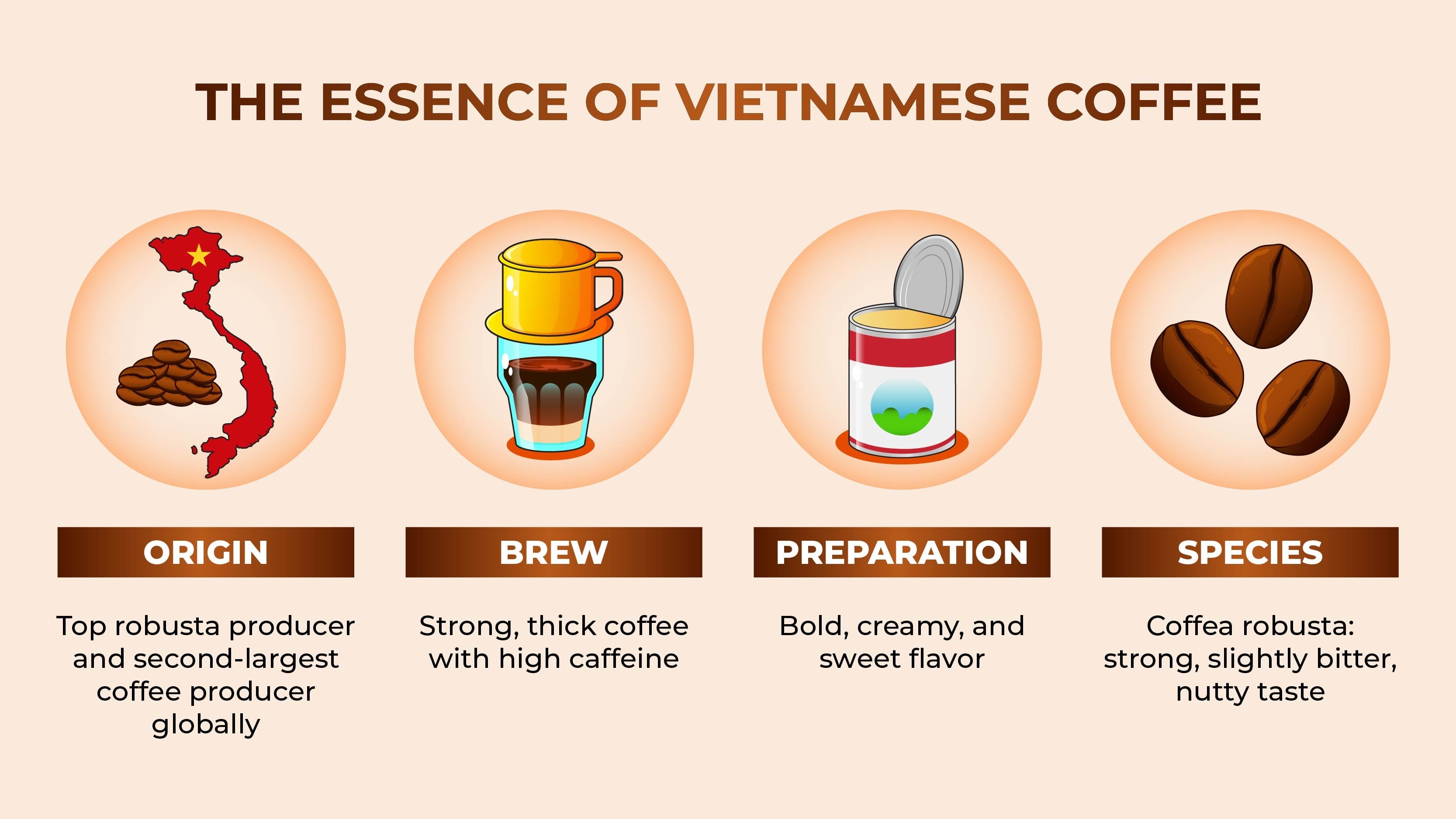 Infographic highlighting the essence of Vietnamese coffee, covering its origin, strong brew, creamy preparation, and robusta coffee beans
Infographic highlighting the essence of Vietnamese coffee, covering its origin, strong brew, creamy preparation, and robusta coffee beans
Here’s a quick comparison of Vietnamese coffee with other global varieties:
| Country | Coffee Bean & Roast | Flavor | Brewing & Serving Method |
|---|---|---|---|
| Vietnamese Coffee | Robusta / Dark Roast | Bold and Intense | Phin / Condensed Milk / Ice |
| American Coffee | Arabica / Medium Roast | Bright and Clear | Drip Machine / Black or with Cream |
| Japanese Coffee | Arabica / Light Roast | Sweet, Mild, Clean | Pour Over / Cold Brew / Espresso |
| Brazilian Coffee | Arabica & Robusta | Nutty, Bittersweet | Espresso / French Press / Cold Brew |
2. Exploring Types Of Vietnamese Coffee Drinks
Vietnamese coffee culture offers an array of preparations. What are some popular Vietnamese coffee drinks?
Exploring Vietnamese coffee culture offers many unique flavors and preparations.
Here are some popular and trending Vietnamese coffee preparations:
- Vietnamese Iced Coffee (Cà Phê Sữa Đá): Robusta coffee blended with condensed milk and served over ice.
- Vietnamese Iced Latte (Bạc Xỉu): A tall glass of ice, condensed milk, and a small amount of coffee. Less bitter than cà phê sữa đá, it’s also known as Saigon-style coffee.
- Vietnamese Black Coffee (Cà Phê Đen): Strong black coffee, enjoyed plain or with sugar.
- Phin Coffee (Cà Phê Phin): Brewed using a traditional phin filter, delivering a bold flavor and caffeine kick.
- Vietnamese Egg Coffee (Cà Phê Trứng): Black coffee with whipped egg yolks and condensed milk, a creamy dessert-like drink.
- Yogurt Coffee (Sữa Chua Cà Phê): Dark black coffee combined with sweetened Vietnamese yogurt.
- Coffee Smoothie (Sinh Tố Cà Phê): Black coffee blended with tropical fruits, ice, and condensed milk.
- Salted Coffee (Cà Phê Muối): Iced Vietnamese coffee with salted cream or sea salt, also called shakerato coffee.
- Civet Coffee (Cà Phê Chồn): Coffee beans eaten and excreted by the Asian palm civet.
- Coconut Coffee (Cà Phê Cốt Dừa): Coconut milk and condensed milk added to strong, phin-brewed coffee.
- Pandan Coffee (Cà Phê Lá Dứa): Vietnamese cold brew mixed with pandan leaves and muscovado sugar.
 Illustration of different types of Vietnamese coffee, including iced coffee, black coffee, egg coffee, coconut coffee, and pandan coffee
Illustration of different types of Vietnamese coffee, including iced coffee, black coffee, egg coffee, coconut coffee, and pandan coffee
3. Delving Into The History Of Vietnamese Coffee
The history of Vietnamese coffee is closely linked to French colonialism. How did Vietnamese coffee history begin?
Vietnam was a French colony from 1883 to 1954. The French introduced a rich coffee culture, which evolved into what it is today. Early colonists favored the fertile volcanic soil, especially in Ninh Bình and Quảng Bình provinces. Despite initial challenges like labor shortages and coffee rust, the shift to the more resistant robusta variety proved successful.
After the Vietnam War, the government encouraged coffee production in the highlands. This led to a resurgence in coffee farming, particularly of robusta, resulting in significant growth in the late 20th century. By the 1990s, Vietnam had become a major player in the global coffee industry.
3.1. Vietnam: A Leading Coffee Exporter
Vietnam holds a significant position in the global coffee market. How large is Vietnam’s coffee export?
In 2023, Vietnam exported 29.7 million bags of coffee, making it the second-largest producer globally (behind Brazil). Vietnamese coffee exports are primarily Coffea robusta (95%), along with smaller quantities of arabica, cherri, moka, and culi beans. Vietnam accounts for 50% of the world’s robusta bean supply, exporting roughly 2.9 tons per hectare of land, compared to Brazil’s 1.4 tons.
 Vietnam exported 29.7 million coffee bags in 2023, with 95% being robusta, contributing 50% of global robusta coffee supply
Vietnam exported 29.7 million coffee bags in 2023, with 95% being robusta, contributing 50% of global robusta coffee supply
4. Brewing Authentic Vietnamese Coffee
The brewing process significantly impacts the final taste of Vietnamese coffee. What is the traditional brewing method for Vietnamese coffee?
Vietnamese coffee is traditionally brewed using a phin filter, a small metal device that combines elements of a French press and a drip coffeemaker. The phin employs a slow-drip process, allowing the coffee to steep thoroughly over several minutes for a stronger, more caffeinated cup.
4.1. Essential Tools & Ingredients
Brewing authentic Vietnamese coffee requires specific tools and ingredients. What do I need to brew Vietnamese coffee?
To brew authentic Vietnamese coffee, gather these items:
- Phin Filter: A metal filter for immersion brewing and drip coffee.
- High-Quality Vietnamese Coffee: Freshly roasted Coffea robusta is ideal.
- Sweetened Condensed Milk: For balancing the strong robusta flavor. Use 2 tablespoons per 5 oz of coffee.
- Coffee Grinder: A burr grinder is best for a fine, sand-like consistency.
- Hot Water: Use a 1:2 or 1:4 coffee-to-water ratio.
- Ice (Optional): For iced coffee, fill your cup with ice.
- Heat Resistant Mug or Glass Cup: Traditional serving ware.
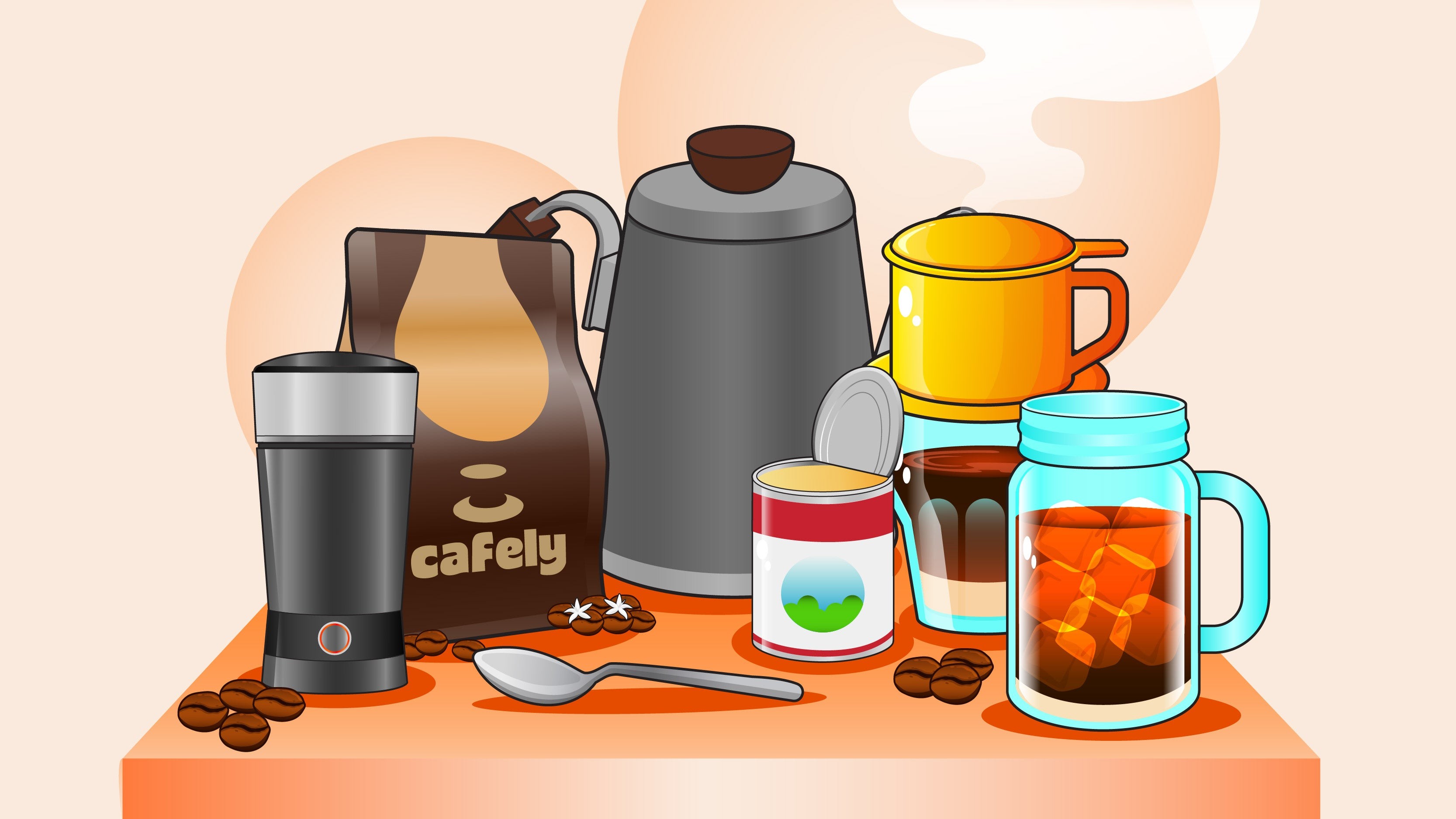 A steaming cup of Vietnamese coffee setup featuring a phin filter, condensed milk, coffee beans, a manual grinder, and iced coffee
A steaming cup of Vietnamese coffee setup featuring a phin filter, condensed milk, coffee beans, a manual grinder, and iced coffee
4.2. Step-By-Step Brewing Guide
Follow these steps for a perfect cup of Vietnamese coffee. How do I brew Vietnamese coffee step by step?
Follow this step-by-step guide to brew authentic Vietnamese-style coffee:
- Measure & Grind the Coffee: Use a medium-fine grind or pre-ground coffee.
- Assemble the Phin Filter: Place the filter plate on your cup and add the brew chamber.
- Add Coffee Grounds: For a 6 oz filter, add about 21 grams (3 tablespoons) of coffee.
- Add the Gravity Press: Distribute the coffee grounds evenly.
- Add the Water (Bloom Stage): Add a small amount of water to “bloom” the coffee for 45 seconds.
- Add the Rest of the Water (Extraction Stage): Fill the chamber with hot water and let it sit for 5–6 minutes.
- Add Sweetener: Use sweetened condensed milk, or other milk and sugar to sweeten.
- Add Ice (Optional): Fill the cup with ice to cool the coffee quickly.
Experiment with coffee-to-water ratios and sweeteners to find your preferred taste.
5. Alternative Brewing Methods
While the phin is traditional, other methods work well. What are alternative ways to make Vietnamese coffee?
While the phin filter is the most traditional method for making Vietnamese coffee, you can use other brewing systems, especially those that craft concentrated coffees. Diluted methods like pour-over or drip coffeemakers are less ideal. Some people compensate by using more coffee grounds for a stronger extraction.
Here are four brewing systems that can be used to make delicious Vietnamese coffee:
5.1. Espresso Machine
- Produces a concentrated shot of coffee quickly.
- Use dark-roasted robusta beans for the best flavor.
- Mix the espresso shot with condensed milk and ice for a traditional taste.
5.2. Moka Pot
- Creates a strong, espresso-like coffee on the stovetop.
- Use a fine grind and pack the coffee tightly.
- Combine the brewed coffee with condensed milk and ice.
5.3. AeroPress
- Offers a quick and versatile brewing method.
- Use a fine grind and a short steep time for a concentrated brew.
- Mix with condensed milk and ice to serve.
5.4. French Press
- Allows for a full immersion brew, resulting in a rich flavor.
- Use a coarse grind and let the coffee steep for 4 minutes.
- Press the plunger gently and mix the coffee with condensed milk and ice.
 Illustration of various coffee brewing methods, including an espresso machine, Moka pot, AeroPress, and French press
Illustration of various coffee brewing methods, including an espresso machine, Moka pot, AeroPress, and French press
6. Indulge In Vietnamese Dessert Coffee Recipes
Vietnamese coffee works wonderfully in dessert coffees. What are some Vietnamese dessert coffee recipes?
The intense flavors of Vietnamese coffee make it ideal for dessert coffees.
6.1. Vietnamese Ube Latte Recipe
This vibrant latte combines coffee with ube (purple yam). How do I make a Vietnamese Ube Latte?
Ube provides a sweet and distinctive flavor.
What You Need:
- High-quality coffee
- Boiling water
- Vietnamese phin filter
- Unsweetened coconut milk/cream
- Ube extract
- Syrup
- Vanilla extract
- Milk of choice
- Ice
- Heatproof cup
- Heat-resistant serving glass
- Whisk
- Measuring spoons
- Mixing bowl
Quick Steps:
- Brew the Coffee: Set up your phin filter, and brew the coffee.
- Prepare the Ube Mix: Combine coconut milk, ube extract, syrup, and vanilla extract. Whisk until mixed.
- Combine & Serve: Pour the ube mix into a serving glass, add ice and milk. Add your brewed coffee over the ube mix to create a layered effect.
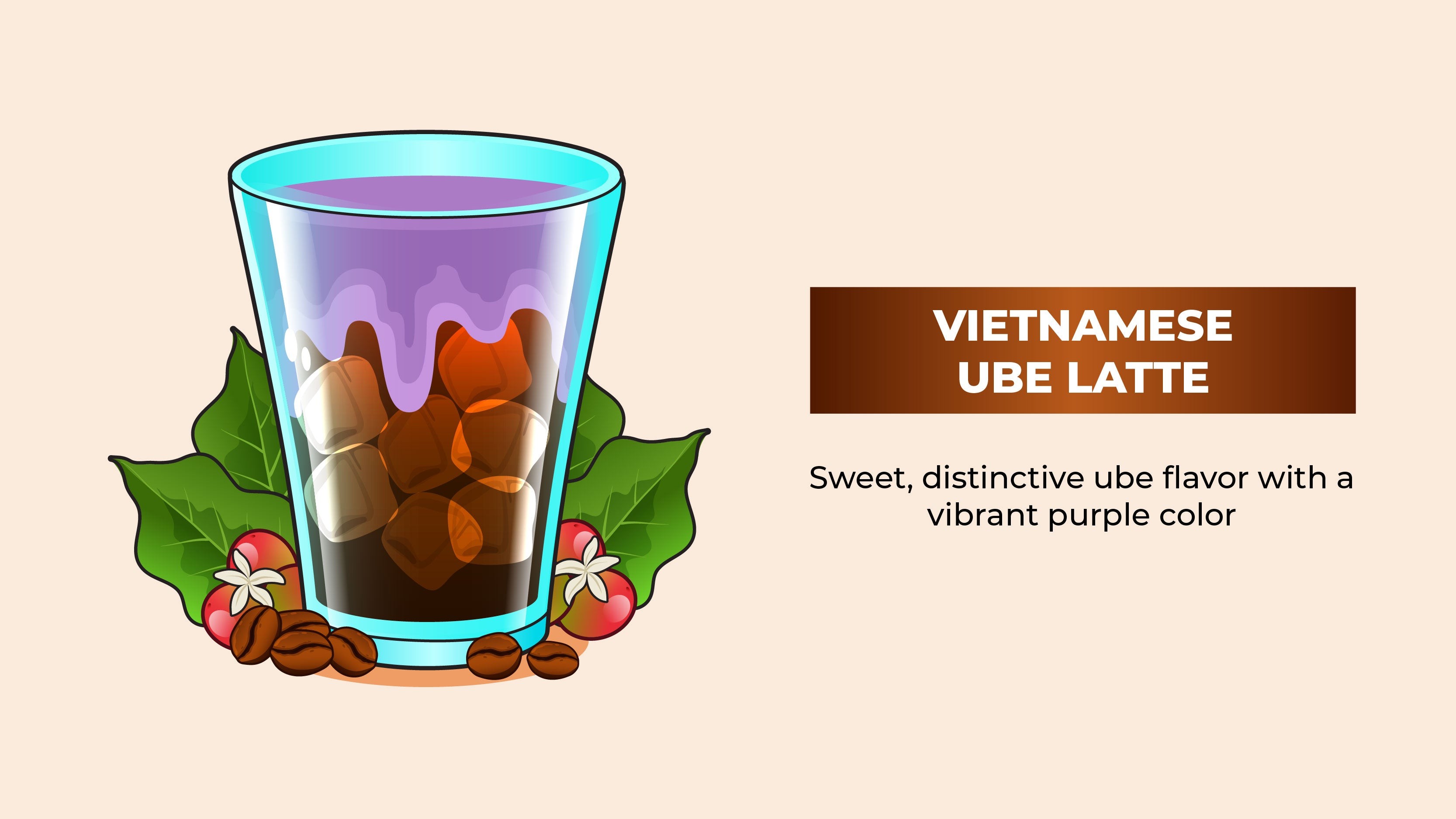 a Vietnamese Ube Latte, featuring a vibrant purple hue, iced coffee, and a sweet, distinctive ube flavor.
a Vietnamese Ube Latte, featuring a vibrant purple hue, iced coffee, and a sweet, distinctive ube flavor.
6.2. Vietnamese Egg Coffee Recipe
The egg foam replaces condensed milk. How is Vietnamese Egg Coffee made?
This offers an incredible creamy texture.
What You Need:
- Ground coffee (robusta recommended)
- Sweetened condensed milk
- White sugar
- Egg yolks
- Boiling water
- Vietnamese phin filter
- Heat-proof bowl
- Electric beater
- Heat-resistant cup
Quick Steps:
- Prepare Egg Foam: Whisk condensed milk and sugar with egg yolks until thick and foamy.
- Brew the Coffee: Measure 2 tablespoons of coffee and brew it.
- Combine & Serve: Pour your coffee into a cup filled with ice. Gently top with egg foam.
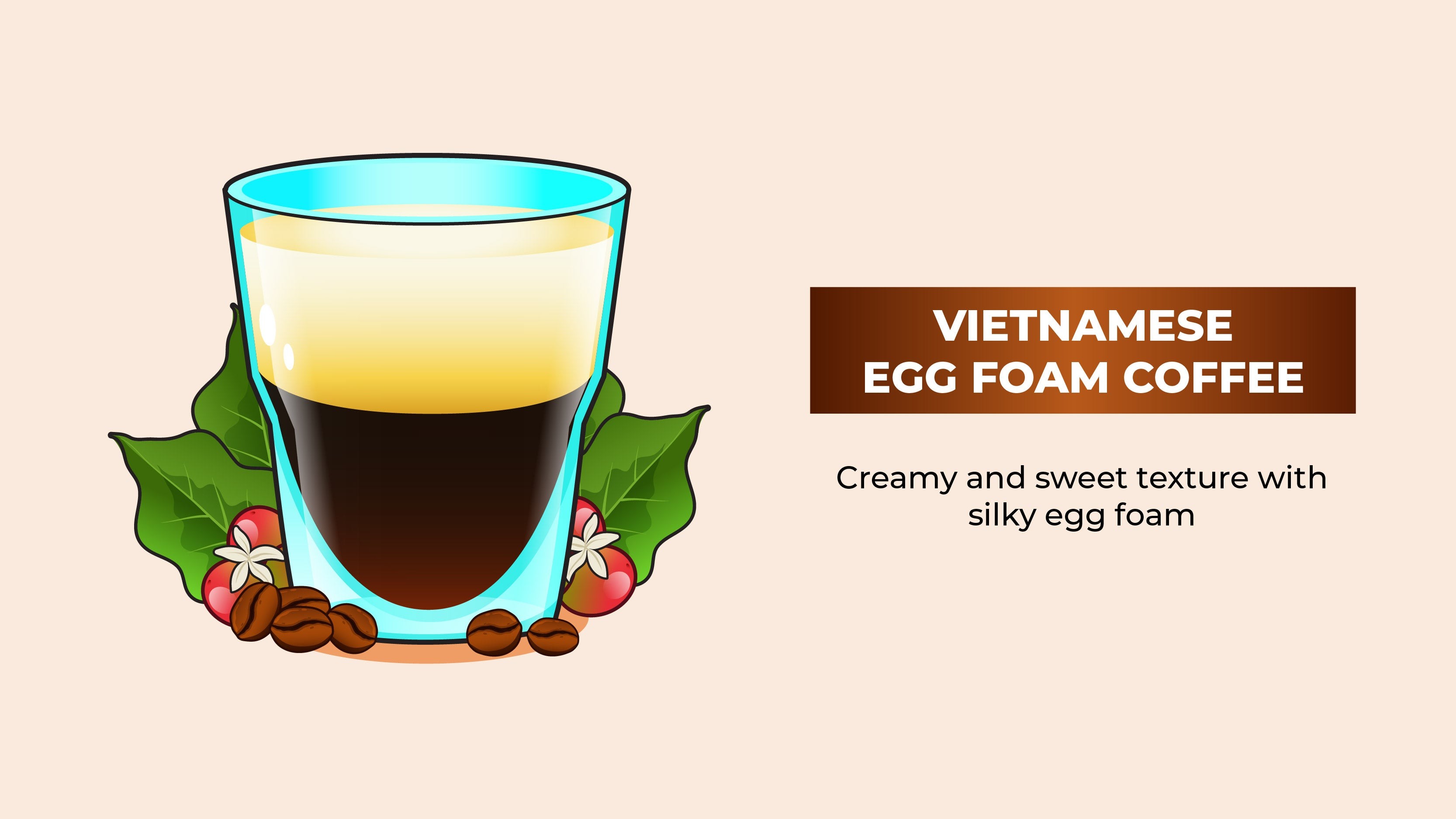 Vietnamese Egg Foam Coffee, showcasing a rich black coffee base topped with a creamy, sweet, and silky egg foam layer
Vietnamese Egg Foam Coffee, showcasing a rich black coffee base topped with a creamy, sweet, and silky egg foam layer
6.3. Vietnamese Coconut Coffee Recipe
A tropical twist on traditional coffee. What ingredients create Vietnamese Coconut Coffee?
What You’ll Need:
- Vietnamese phin filter
- Coffee grinder (if using whole beans)
- Robusta coffee
- Boiling water
- Canned, full-fat coconut milk/cream
- Sweetened condensed milk
- Heat-resistant glass cup
- Frother or shaker (optional)
Quick Steps:
- Grind Coffee: Grind your coffee to a fine consistency.
- Set Up Phin: Place the phin filter over your cup and add coffee grounds.
- Brew Coffee: Pour enough boiling water to cover the grounds, let it bloom, then fill to just below the brim.
- Heat Milk: Warm coconut milk with condensed milk until hot.
- Froth (Optional): Froth the coffee or milk.
- Combine & Serve: Mix the coffee with your heated milk mixture. Add toppings like shredded coconut if desired.
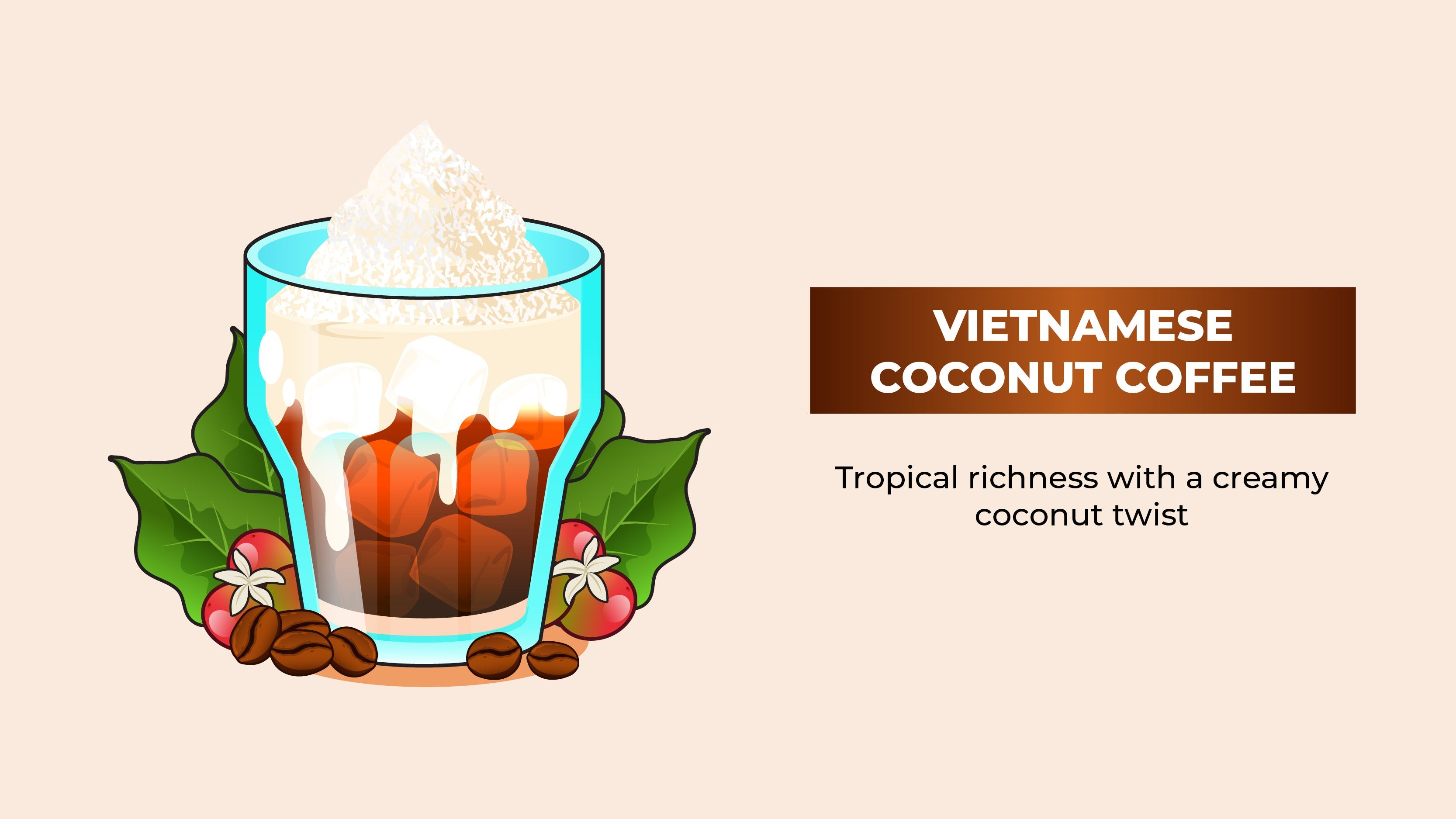 Vietnamese Coconut Coffee, featuring iced coffee with a creamy coconut topping, highlighting its tropical richness
Vietnamese Coconut Coffee, featuring iced coffee with a creamy coconut topping, highlighting its tropical richness
7. The Iconic Vietnamese Phin Filter
The phin filter is central to Vietnamese coffee culture. What is a Vietnamese phin filter?
At the heart of Vietnamese coffee culture is the phin filter, a compact, drip-style coffee maker crafted from metal. It is suited to the deep, rich, and intense flavors extracted by Vietnamese robusta coffee. Invented in the 20th century, it quickly gained popularity for its low cost, simple design, and absence of disposable filters.
7.1. Understanding The Anatomy Of A Phin Filter
The phin filter comprises four key parts. What are the main components of a phin filter?
The phin consists of 4 key parts:
- The Cap: Maintains the water’s heat as the coffee brews.
- The Gravity Press: Ensures a thorough and consistent extraction.
- The Brew Chamber: Where the coffee steeps in water.
- The Filter Plate: Separates the fresh coffee from the grounds.
 a Vietnamese Phin Filter, labeling its components: cap, gravity press, brew chamber, and filter plate for coffee brewing
a Vietnamese Phin Filter, labeling its components: cap, gravity press, brew chamber, and filter plate for coffee brewing
8. Appreciating Vietnamese Robusta Coffee
Vietnamese coffee uses robusta beans. What makes Vietnamese robusta coffee unique?
Coffea arabica has been the world’s standard, but it’s challenging to grow. In Vietnam, lower altitudes favor robusta, which thrives in these conditions and yields high-quality beans. Through climate adaptations and rich basalt soil, Vietnam has established a reputation for robusta beans. The phin filter and sweetened condensed milk complement robusta’s intense flavors. Local innovations, like adding egg, condensed milk, yogurt, and fresh fruit, have transformed Vietnamese coffee.
9. Exploring Southeast Asian Coffee Variations
Coffee is popular across Southeast Asia. How does Vietnamese coffee compare to other Southeast Asian coffees?
Coffee culture thrives throughout Southeast Asia, particularly in Vietnam, Indonesia, and Malaysia. Each region has developed its unique coffee culture with distinctive recipes and bean varieties. The tropical climate is ideal for growing coffee, with Southeast Asia producing approximately 29 million bags annually. Southeast Asian coffee often uses robusta beans, is served over ice, and incorporates local fruits and spices like coconut, chocolate, or cinnamon.
Examples of other Asian coffee styles:
- Thai Coffee (Oliang): A blend of coffee, sesame seeds, and sometimes corn, served sweetened and iced.
- Indonesian Coffee (Kopi Tubruk): Coffee grounds are boiled with sugar and served unfiltered.
- Malaysian Coffee (Kopi-O): Black coffee brewed with robusta and a sock filter, served with sugar.
- Ipoh White Coffee: Coffee beans roasted with palm oil margarine and served with condensed milk.
- Filipino Barako Coffee: Made with Coffea liberica, known for its strong flavor.
- Laotian Coffee: Mostly robusta and arabica blends, served strong with sweetened condensed milk.
- Burmese Coffee (Café Yauk): Brewed strong and served sweet with condensed milk.
10. FAQs: Understanding Vietnamese Coffee
Find answers to common questions about Vietnamese coffee. What are some frequently asked questions about Vietnamese coffee?
 a Vietnamese Phin coffee filter brewing a rich, dark coffee in a glass, surrounded by coffee beans and fresh coffee plant leaves
a Vietnamese Phin coffee filter brewing a rich, dark coffee in a glass, surrounded by coffee beans and fresh coffee plant leaves
10.1. How much caffeine is in Vietnamese coffee?
A typical 4-ounce cup of Vietnamese coffee contains between 66 and 130 mg of caffeine. Caffeine levels depend on the beans, roast level, and volume of coffee.
10.2. How much coffee is produced annually in Vietnam?
Approximately 29.75 million bags of coffee were produced last year, with rising popularity expected to increase this figure in 2024.
10.3. Is robusta coffee sustainable?
Yes, robusta plants are hardier and need less specific conditions than arabica. They require less attention and produce higher yields.
10.4. How does Vietnamese coffee differ from other coffees?
Vietnamese coffee uses robusta beans, often with unique additions like condensed milk, yogurt, or egg yolk.
10.5. Can I brew Vietnamese coffee without a phin filter?
Yes, use a French press, espresso machine, AeroPress, moka pot, or drip coffeemaker.
10.6. Can I make Vietnamese coffee without condensed milk?
Yes, enjoy it black or use alternative sweeteners.
10.7. Is robusta coffee stronger than arabica?
Yes, robusta coffee contains more caffeine and has a stronger flavor.
10.8. Is Vietnamese Coffee Healthy?
Robusta coffee offers health benefits in moderation. However, too much caffeine or sweetened condensed milk can have negative effects.
Planning a trip to Vietnam? Navigating a new country can be challenging, but SIXT.VN is here to help. We offer convenient airport transfer services to get you from the airport to your hotel hassle-free. Our services include reliable airport pickup and drop-off. Visit SIXT.VN for easy booking and a stress-free travel experience.
Address: 260 Cau Giay, Hanoi, Vietnam
Hotline/Whatsapp: +84 986 244 358
Website: SIXT.VN



